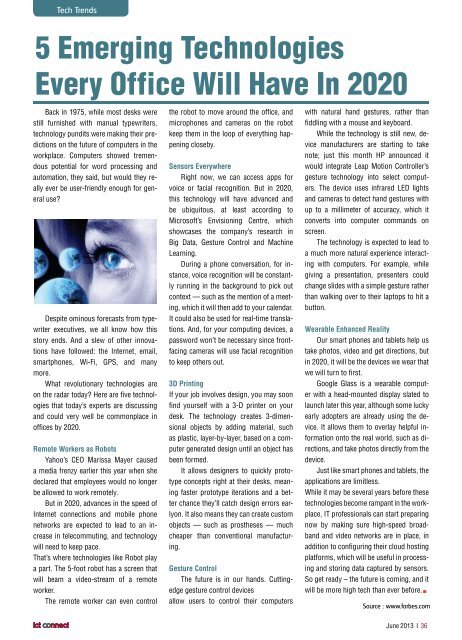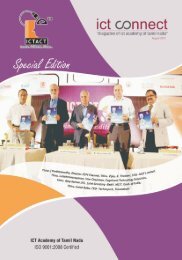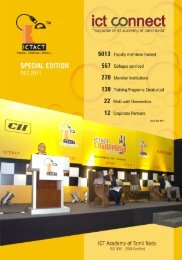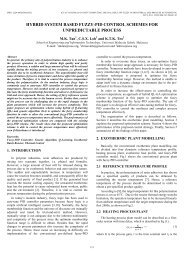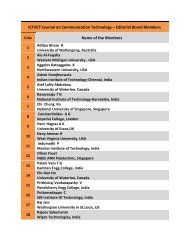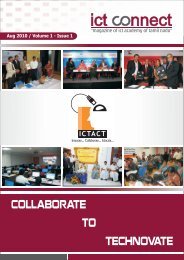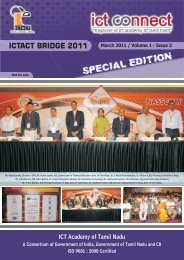Volume 1 - Issue 8 - ICTACT.IN
Volume 1 - Issue 8 - ICTACT.IN
Volume 1 - Issue 8 - ICTACT.IN
Create successful ePaper yourself
Turn your PDF publications into a flip-book with our unique Google optimized e-Paper software.
Tech Trends5 Emerging TechnologiesEvery Office Will Have In 2020Back in 1975, while most desks werestill furnished with manual typewriters,technology pundits were making their predictionson the future of computers in theworkplace. Computers showed tremendouspotential for word processing andautomation, they said, but would they reallyever be user-friendly enough for generaluse?Despite ominous forecasts from typewriterexecutives, we all know how thisstory ends. And a slew of other innovationshave followed: the Internet, email,smartphones, Wi-Fi, GPS, and manymore.What revolutionary technologies areon the radar today? Here are five technologiesthat today’s experts are discussingand could very well be commonplace inoffices by 2020.Remote Workers as RobotsYahoo’s CEO Marissa Mayer causeda media frenzy earlier this year when shedeclared that employees would no longerbe allowed to work remotely.But in 2020, advances in the speed ofInternet connections and mobile phonenetworks are expected to lead to an increasein telecommuting, and technologywill need to keep pace.That’s where technologies like Robot playa part. The 5-foot robot has a screen thatwill beam a video-stream of a remoteworker.The remote worker can even controlthe robot to move around the office, andmicrophones and cameras on the robotkeep them in the loop of everything happeningcloseby.Sensors EverywhereRight now, we can access apps forvoice or facial recognition. But in 2020,this technology will have advanced andbe ubiquitous, at least according toMicrosoft’s Envisioning Centre, whichshowcases the company’s research inBig Data, Gesture Control and MachineLearning.During a phone conversation, for instance,voice recognition will be constantlyrunning in the background to pick outcontext — such as the mention of a meeting,which it will then add to your calendar.It could also be used for real-time translations.And, for your computing devices, apassword won’t be necessary since frontfacingcameras will use facial recognitionto keep others out.3D PrintingIf your job involves design, you may soonfind yourself with a 3-D printer on yourdesk. The technology creates 3-dimensionalobjects by adding material, suchas plastic, layer-by-layer, based on a computergenerated design until an object hasbeen formed.It allows designers to quickly prototypeconcepts right at their desks, meaningfaster prototype iterations and a betterchance they’ll catch design errors earlyon.It also means they can create customobjects — such as prostheses — muchcheaper than conventional manufacturing.Gesture ControlThe future is in our hands. Cuttingedgegesture control devicesallow users to control their computerswith natural hand gestures, rather thanfiddling with a mouse and keyboard.While the technology is still new, devicemanufacturers are starting to takenote; just this month HP announced itwould integrate Leap Motion Controller’sgesture technology into select computers.The device uses infrared LED lightsand cameras to detect hand gestures withup to a millimeter of accuracy, which itconverts into computer commands onscreen.The technology is expected to lead toa much more natural experience interactingwith computers. For example, whilegiving a presentation, presenters couldchange slides with a simple gesture ratherthan walking over to their laptops to hit abutton.Wearable Enhanced RealityOur smart phones and tablets help ustake photos, video and get directions, butin 2020, it will be the devices we wear thatwe will turn to first.Google Glass is a wearable computerwith a head-mounted display slated tolaunch later this year, although some luckyearly adopters are already using the device.It allows them to overlay helpful informationonto the real world, such as directions,and take photos directly from thedevice.Just like smart phones and tablets, theapplications are limitless.While it may be several years before thesetechnologies become rampant in the workplace,IT professionals can start preparingnow by making sure high-speed broadbandand video networks are in place, inaddition to configuring their cloud hostingplatforms, which will be useful in processingand storing data captured by sensors.So get ready – the future is coming, and itwill be more high tech than ever before.Source : www.forbes.comJune 2013 I 36


